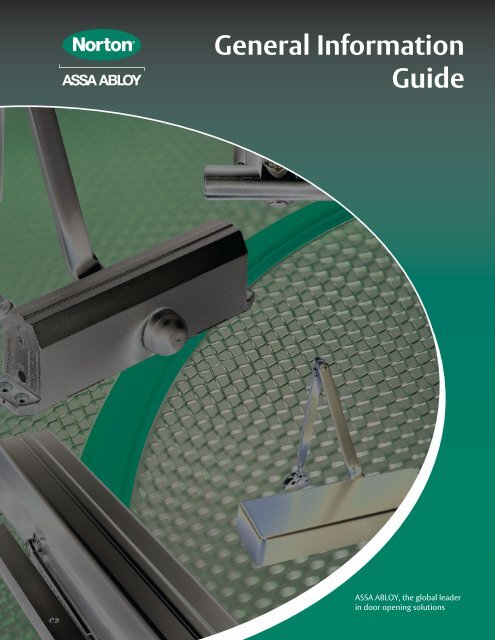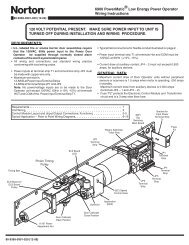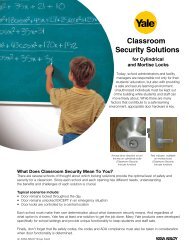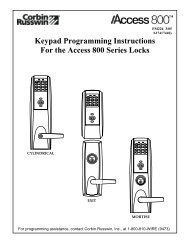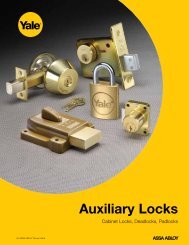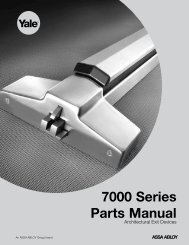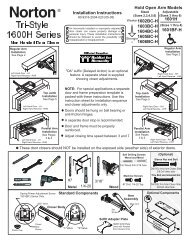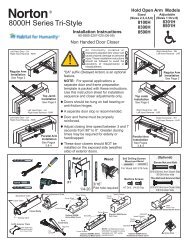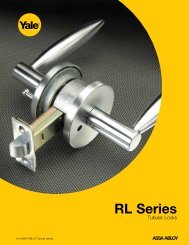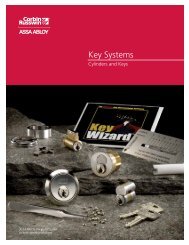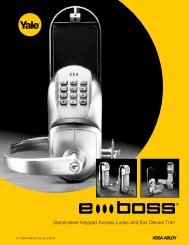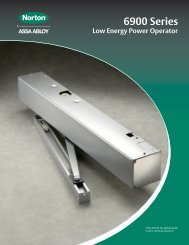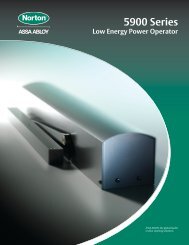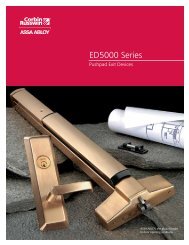General Information Guide - ASSA ABLOY Door Security Solutions ...
General Information Guide - ASSA ABLOY Door Security Solutions ...
General Information Guide - ASSA ABLOY Door Security Solutions ...
You also want an ePaper? Increase the reach of your titles
YUMPU automatically turns print PDFs into web optimized ePapers that Google loves.
<strong>General</strong> <strong>Information</strong><br />
<strong>Guide</strong><br />
<strong>ASSA</strong> <strong>ABLOY</strong>, the global leader<br />
in door opening solutions
GeNerAL<br />
INFOrmATION<br />
About Norton <strong>Door</strong> Controls…<br />
Today's modern Norton ® door control began with Lewis C. Norton, the inventor of the first American door closer.<br />
In 1880, he organized the Norton <strong>Door</strong> Check Company to manufacture and market his product: the first practical,<br />
commercial door closer. Though cumbersome, his first door closers were effective devices which permitted the<br />
adjustment of the door's sweep speed.<br />
In later years, Norton <strong>Door</strong> Controls refined the rack and pinion closer and the concept of a valve-controlled backcheck<br />
for hydraulic closers. Along the way there have been a variety of other innovations, including the aluminum alloy body,<br />
narrow style, non-handed closers, adjustable backcheck, speed adjustments and special application arms. As Fire/Life<br />
Safety Standards were updated, Norton introduced the 7200 Series Electromechanicals and later the Power Track ® . In<br />
1990 , the American with Disabilities Act (ADA) was passed, requiring buildings to have handicapped accessible doors<br />
for the physically challenged. This law brought about the creation of the original PowerMatic ® Low Energy Operator.<br />
Today, Norton <strong>Door</strong> Controls offers traditional surface, industrial economy, overhead concealed, security, commercial,<br />
architectural, electromechanical and electrified closers. To complement the closers, Norton also offers a unique range<br />
of arms to help provide maximum door and frame protection. The Norton philosophy has been – and continues to be –<br />
one of constant improvement…of quality products.<br />
Since 1957 Norton <strong>Door</strong> Controls have been manufactured in Monroe, North Carolina.<br />
<strong>Door</strong> Closer <strong>General</strong> <strong>Information</strong><br />
The <strong>ASSA</strong> <strong>ABLOY</strong> <strong>Door</strong> <strong>Security</strong> <strong>Solutions</strong> Sales Force… Specialists in <strong>Door</strong> Control<br />
Each <strong>ASSA</strong> <strong>ABLOY</strong> Sales Representative is selected for his knowledge of hardware and his ability to provide assistance<br />
to both specifier and user. His technical background and intimate understanding of Norton door closers and their<br />
applications are available to the specifier when a project is in the planning stages. When the project is complete he<br />
inspects the installation and instructs the maintenance staff on how to adjust each door control.<br />
The <strong>ASSA</strong> <strong>ABLOY</strong> <strong>Door</strong> <strong>Security</strong> <strong>Solutions</strong> Representatives are supported by a Technical Product Support Department to<br />
help solve field problems. Together, these specialists can overcome most installation difficulties.<br />
Special Templates<br />
All Norton door closers and door controls are supplied with instructions that show the correct mounting position for<br />
the closer and arm in relation to the door, frame and hinges or offset pivots for a variety of door openings.<br />
Templates are available upon request for special conditions, such as center pivoted doors. Whenever you need<br />
assistance with a door control application or specification, contact your <strong>ASSA</strong> <strong>ABLOY</strong> <strong>Door</strong> <strong>Security</strong> <strong>Solutions</strong><br />
Representative.<br />
TABLe OF<br />
CONTeNTS<br />
<strong>General</strong> <strong>Information</strong> . . . . . . . . . . . . . . . . . . . . . . . . . . . . . . . . . . . . . . . . . . . . . . . . . . . . . . . . . . . . . . . . . . . . . . . . . . . . . . . . . . . . . . . . . . . . . . . . . . . . . 2<br />
Listings and Approvals/Specifications . . . . . . . . . . . . . . . . . . . . . . . . . . . . . . . . . . . . . . . . . . . . . . . . . . . . . . . . . . . . . . . . . . . . . . . . . . . . . . . . . . . . . 3<br />
Glossary of Terms . . . . . . . . . . . . . . . . . . . . . . . . . . . . . . . . . . . . . . . . . . . . . . . . . . . . . . . . . . . . . . . . . . . . . . . . . . . . . . . . . . . . . . . . . . . . . . . . . . . . . . . . 5<br />
How a <strong>Door</strong> Closer Works . . . . . . . . . . . . . . . . . . . . . . . . . . . . . . . . . . . . . . . . . . . . . . . . . . . . . . . . . . . . . . . . . . . . . . . . . . . . . . . . . . . . . . . . . . . . . . . . 9<br />
<strong>Door</strong> Closer Sizes . . . . . . . . . . . . . . . . . . . . . . . . . . . . . . . . . . . . . . . . . . . . . . . . . . . . . . . . . . . . . . . . . . . . . . . . . . . . . . . . . . . . . . . . . . . . . . . . . . . . . . . 13<br />
meeting A .D .A requirements . . . . . . . . . . . . . . . . . . . . . . . . . . . . . . . . . . . . . . . . . . . . . . . . . . . . . . . . . . . . . . . . . . . . . . . . . . . . . . . . . . . . . . . . . . . . 14<br />
2<br />
www.nortondoorcontrols.com 6/10
<strong>Door</strong> Closer <strong>General</strong> <strong>Information</strong><br />
Listings/Approvals<br />
Norton ® door closers have been designed and manufactured to conform with government and industry standards. For<br />
particulars not covered in this section, please contact your Sales Representative.<br />
Underwriters' Laboratories, Inc .<br />
All Norton door controls are listed by Underwriters' Laboratories, Inc.<br />
State and Local Listings<br />
Norton Series 7200, Series 7700PTO/7700PTDO, Series 7900, Series 7706STP and Series 6900 are listed with the<br />
California State Fire Marshal for use on fire doors.<br />
Norton door closers are approved by the New York City Material and Equipment Acceptance Division.<br />
GeNerAL<br />
INFOrmATION<br />
There has been increased emphasis by all parties associated with the construction and operation of buildings to make<br />
facilities accessible to and usable by handicapped people. Certain Norton door controls have features or modifications<br />
that help achieve these requirements.<br />
To assist you in recognizing these controls, they are called to your attention throughout this catalog by the handicapped<br />
symbol.<br />
Federal and Industry Specifications<br />
The following information is provided as a cross-reference. Use it as a guide to door closer design and function only. For additional<br />
questions, please contact your Sales Representative.<br />
6/10<br />
Norton Series<br />
Number<br />
FF-H-121c<br />
Federal Spec Type<br />
www.nortondoorcontrols.com<br />
ANSI Type A156-4<br />
78-B/F 3001-3004-3009 C01000 W/O PT 4A-4C-4D-4F-4H<br />
1600BC<br />
1601<br />
1700<br />
1700BC<br />
3009<br />
3009<br />
3009<br />
3009<br />
C03000 W/O PT 4A-4D<br />
C03000 W/O PT 4A-4B-4C-4D-4F-4H<br />
C03000 W/O PT 4A<br />
C03000 W/O PT 4A-4D<br />
7500 3001-3004-3009-3230 (MOD) C02000 W/O PT 4A-4B-4C-4D-4F-4H-4J<br />
7700<br />
7900<br />
C03000<br />
C02000 W/O PT 4A-4B-4C-4D-4F-4J<br />
C05030, C05040, C05050, W/O PT 4B-4C-4D-4F-4H<br />
8100 3001-3004-3009 C03000 W/O PT 4A-4B-4C-4D-4F<br />
8300 3001-3004-3009 C02000 W/O PT 4A-4B-4C-4D-4F<br />
8301 3001-3004-3009 C02000 W/O PT 4A-4B-4C-4D-4F-4H<br />
8500<br />
3001-3004-3009-3230 (MOD)<br />
C02000 W/O PT 4A-4B-4C-4D-4F<br />
8501<br />
3001-3004-3009-3230 (MOD)<br />
C02000 W/O PT 4A-4B-4C-4D-4F-4H<br />
9300BC 3009 C03000 W/O PT 4A-4D<br />
4A - +15% Power Adjustment 4F - Delayed Action Closing<br />
4B - +35% Power Adjustment 4G - Factory Set Dead Stop<br />
4C - +50% Power Adjustment 4H - Adjustable Range of Closing Force<br />
4D - Adjustable Backcheck 4J - Backcheck Shall Be Advanced 15°<br />
Accessibility Code<br />
Closers<br />
Norton Series 1601BF,<br />
Series 7500, Series<br />
8301 and Series<br />
8501 have been<br />
designed to conform<br />
to the requirements<br />
outlined in ANSI<br />
A117.1<br />
For Buildings and<br />
Facilities — Providing<br />
Accessibility For<br />
Physically<br />
Handicapped<br />
People.<br />
3
GeNerAL<br />
INFOrmATION<br />
4<br />
<strong>Door</strong> Closer <strong>General</strong> <strong>Information</strong><br />
Federal and Industry Specifications (continued)<br />
The following information is provided as a cross reference. Use it as a guide to door closer design and function only. For additional<br />
questions, please contact your Sales Representative.<br />
Norton ® Series Number ANSI Type A156 .15<br />
7700PTO<br />
7700PTDO<br />
P7700PTO<br />
P7700PTDO<br />
Norton Series Number<br />
7210MPO<br />
7210MPDO<br />
7210MPSO<br />
7220/7230MPO<br />
7220/7230MPDO<br />
7220/7230MPSO<br />
7240MPO<br />
7240MPDO<br />
7240MPSO<br />
7250MPO<br />
7250MPDO<br />
7250MPSO<br />
CO0191<br />
CO0201<br />
CO0231<br />
CO0241<br />
ANSI Type A156 .15<br />
Type Number Type of Installation<br />
C00351<br />
C00361<br />
C00351<br />
C00311<br />
C00321<br />
C00311<br />
C00371<br />
C00381<br />
C00371<br />
C00391<br />
C00401<br />
C00391<br />
Rigid<br />
Slide<br />
Arm<br />
Track<br />
Double<br />
Lever<br />
Arm<br />
Connected<br />
Free<br />
Swing<br />
Arm<br />
Double<br />
Egress<br />
Arm<br />
7290MPO C00651 Overhead Concealed<br />
www.nortondoorcontrols.com 6/10
<strong>Door</strong> Closer <strong>General</strong> <strong>Information</strong><br />
Glossary of <strong>Door</strong> and Frame Terms<br />
A number of basic terms are used in the description of doors,<br />
frames and the application of door closers to them. Knowledge<br />
of these basic terms will provide a better understanding of this<br />
catalog.<br />
<strong>Door</strong> Top rail: The horizontal rail at the top of the door.<br />
rabbet: The section of the door frame recessed to receive the<br />
door.<br />
Soffit: The flat surface on the underside of the frame between the<br />
vertical frame stops.<br />
Stop: The part of the frame against which the door closes.<br />
Frame Face: The exposed part of the frame which is generally<br />
parallel to the wall on metal frames. On wood frames this would<br />
be the frame molding.<br />
reveal: The distance from the frame face to the surface of the<br />
door.<br />
Applications<br />
6/10<br />
www.nortondoorcontrols.com<br />
GLOSSArY OF<br />
TermS<br />
regular Arm: A type of door closer installation. The closer is mounted on the hinge side top rail of the door. The arm is attached to<br />
the frame face at a right angle to the door.<br />
Parallel Arm: A type of door closer installation. The closer is mounted on the opposite to hinge side top rail of the door. The arm is<br />
attached to the frame soffit parallel to the door.<br />
Top Jamb: A type of door closer installation. The closer is mounted on the opposite to hinge side frame face, above the door. The arm<br />
is attached to the top rail of the door at a right angle to the door.<br />
Slide Track Closers: A type of door closer installation. The closer is mounted on either the hinge side or opposite hinge side. The slide<br />
track is mounted to frame face on the hinge side, and the frame soffit on the opposite to hinge side.<br />
Corner Bracket Closers: A type of installation when the closer cannot be mounted to either the door or the frame. The bracket is<br />
mounted on the upper corner of the push side hinge jamb of the frame. The closer is mounted to the bracket and the arm is attached<br />
to the top rail of the door at a right angle to the door.<br />
5
GLOSSArY OF<br />
TermS<br />
<strong>General</strong> Terms<br />
6<br />
<strong>Door</strong> Closer <strong>General</strong> <strong>Information</strong><br />
Adjustable Backcheck Cushioning: A term used to indicate that the strength of "backcheck cushioning" in the door's opening cycle<br />
can be regulated by means of a valve in the closer body.<br />
Adjustable Backcheck Position: A term used to indicate that the location where "backcheck cushioning" occurs in the door's opening<br />
cycle can be adjusted by means of a valve in the closer body. This valve provides a range of 20° of door opening where the backcheck<br />
can be set.<br />
Adjustable Latch Speed: A term used to indicate that a door's speed can be regulated in the "latch" range of the closing cycle<br />
(approximately the last 5° of closing) by means of a valve in the closer body.<br />
Adjustable Sweep Speed: A term used to indicate that a door's speed can be regulated in the "sweep" range of the closing cycle (fully<br />
open to 5° from closed) by means of a valve in the closer body.<br />
Adjustable Delayed Action Closing: This special door control feature adds a third speed range to the closing control cycle. It becomes<br />
effective when the door is opened and released at any point beyond 70°. This delayed closing enables traffic to clear the opening<br />
before the normal closing cycle starts.<br />
Hand (of a door): A term used to describe the direction of a door's swing. When looking at a door — if the hinges are on the right and<br />
the door swings away from you, the door is a right hand. If the hinges are on the left and the door swings away from you, the door is a<br />
left hand.<br />
Handed: A term used to describe a product that can only be used with either a right hand door or a left hand door, not both.<br />
Non-Handed: Products are said to be non-handed when they can be installed, without modification, on either a right or left hand<br />
door.<br />
Field reversible: Handed products are said to be field reversible when the arrangement of their component parts can be changed<br />
to permit their operation on a door of the opposite hand. Often, the labor cost necessary to reverse the hand of a closer makes it<br />
desirable to order a closer of the correct hand.<br />
Hold Open: Any means which is employed to maintain a door in an open position.<br />
Friction Hold Open: This type of hold-open consists of two friction surfaces connected by a threaded stud. As the closer arm rotates,<br />
the two friction surfaces bind against each other. The amount of friction can be adjusted by means of a nut at the friction point.<br />
Fusible-Link Friction Hold Open: This is a form of friction hold open that employs a fusible link and spring-loaded clamp assembly at<br />
the hold open friction joint. The heat from a fire will melt the fusible link, which releases the spring-loaded clamp assembly, relieving<br />
pressure on the friction joint and permitting the door closer to close the door. (Fusible link is not recognized by NFPA therefore Norton<br />
does not offer this type arm).<br />
mechanical Hold Open: Norton uses two types of mechanical hold open. One is a plunger type, whereby a spring-loaded plunger<br />
assembly engages either a ball rivet or a detent in a mating part. The other is a spring-loaded roller catch within a slide track.<br />
www.nortondoorcontrols.com 6/10
<strong>Door</strong> Closer <strong>General</strong> <strong>Information</strong><br />
GLOSSArY OF<br />
TermS<br />
Hydraulic Hold Open: This is the type of hold open employed in Norton ® electromechanical closer-holders. An electrically controlled<br />
plunger assembly seals a chamber within the door closer to permit hydraulic fluid to flow in only one direction. Since the fluid is<br />
trapped in this chamber, the closer spring is prevented from closing the door. When power to the unit is interrupted, the plunger<br />
valve opens and releases the door from hold open. The door can also be released from hold open by pushing the door toward the<br />
closed position with enough force (approximately 15 to 20 lbs.) to overcome the holding force on the plunger valve.<br />
Telephone Booth <strong>Door</strong> Closer: This special-feature door control holds the door open approximately 5° when the booth is not in use.<br />
When the booth is being used, the door can be closed by the user.<br />
Coupon Booth Hold Open: This special-feature door control will hold a door open at approximately 15°. When the door is opened<br />
more than 80° the closer will then close and latch the door. This special-feature closer is generally used on safe deposit box inspection<br />
cubicles in banks.<br />
Hospital Hold Open: This special-feature door control can hold a door open at any one of three points; approximately 15°, 45° and<br />
90° or beyond. This special-feature closer is generally used where ventilation and privacy are required without having the door fully<br />
closed.<br />
Individually Sized Closers: These closers are sized 2, 3, 4, 5 or 6 with each size having a different spring assembly. Each spring<br />
assembly provides a minimum closing force that determines its size.<br />
multi-Size Power Adjustment Closers: These closers have a spring assembly that can be adjusted through a wide power range.<br />
Closers with this feature are not individually sized but must be field adjusted through a range of sizes to meet the power needs of the<br />
door.<br />
50% Power Adjustment: The closer has an external adjustment that allows preloading of the spring. Depending on the needs of the<br />
specific installation, closer power can be increased 50% over the minimum closing force for any size closer.<br />
Adjusta-Power Shoe: This standard non-hold open regular arm or top jamb shoe has three mounting holes. By relocating the closer<br />
arm, the closer's power can – in effect – be adjusted 15% (7-1/2% increase or decrease). It provides a simple method of adjusting closer<br />
power to meet the need of the specific installation.<br />
Low Profile Arm: A term used to describe an arm which has a minimum space requirement in the vertical distance between the closer<br />
pinion and the arm bracket. It requires less mounting space than closers with standard arms.<br />
Non-Critical Valves: These are control valves used to regulate the flow of fluid – in contrast to valves that are either fully open or fully<br />
closed. Norton closer control valves have been designed to provide fine tuned hydraulic control.<br />
Parallel rigid Arm: This is a heavy-duty, non-telescoping forearm used in conjunction with a heavy-duty soffit plate.<br />
reveal: The distance measured from the surface of the frame face to the surface of the door.<br />
Tri-Style ® Packaging: The closer is packed with all necessary hardware for mounting in any of the three traditional mounting styles:<br />
Regular Arm, Parallel Arm or Top Jamb. Non-hold open closers have an Adjusta-Power shoe for regular arm and top jamb mounting<br />
and a soffit plate for parallel arm mounting. Hold open closers have the hold open arm for regular arm and top jamb mounting and a<br />
soffit adapter plate for parallel arm mounting.<br />
6/10<br />
www.nortondoorcontrols.com<br />
7
GLOSSArY OF<br />
TermS<br />
<strong>General</strong> Terms…(continued)<br />
8<br />
<strong>Door</strong> Closer <strong>General</strong> <strong>Information</strong><br />
Unitrol ® <strong>Door</strong> Control: This is a proprietary Norton ® door closer, door holder and shock absorbing door stop combination.<br />
CloserPlus ® : This is a combination of a door closer and an arm having a built-in positive stop. A hold open feature which may be<br />
engaged or disengaged as necessary is available as an option.<br />
electromechanical Closer-Holder: This is a door closer equipped with an electromechanical device which permits the door to be held<br />
open. When the door is manually pushed toward "closed," the holding mechanism releases and the door closes normally. The holding<br />
mechanism can also be released by means of fire/smoke detectors. Norton Closer-Holders are available with or without a built-in/<br />
integral fire/smoke detector.<br />
Power Track ® Closer-Holders: This is a slide track equipped with an electrically operated hold open mechanism. When the door is<br />
pushed toward "closed" the hold open mechanism will disengage and allow the door to close. The holding mechanism can be released<br />
by either a self-contained fire/smoke detector or by any compatible remote fire/smoke detection system.<br />
executive <strong>Door</strong> Holder/releaser: Garage door operator radio frequency technology is applied to the hold open of executive office<br />
doors. During normal office business the door is held open. When the executive requires security or privacy he pushes the button on<br />
the remote hand-held transmitter. The switch in the receiver operates and interrupts the hold open circuit to allow the door to close.<br />
Positive Stop: A physical limit to the opening of a door. It may be provided by means of floor or wall – mounted stops – usually with<br />
resilient bumpers — or by means of a limit imposed by the arm of the door closer. Norton's CloserPlus is an example of the latter.<br />
www.nortondoorcontrols.com 6/10
<strong>Door</strong> Closer <strong>General</strong> <strong>Information</strong><br />
How a <strong>Door</strong> Closer Works<br />
The basic function of a door closer is to provide a smooth,<br />
controlled closing action to the door after the door has been<br />
opened and released. A modern rack and pinion door closer<br />
provides this function in the following manner:<br />
As the door is opened, the closer arm transmits motion to<br />
the piston in the closer housing smoothly and precisely. This<br />
action compresses the spring which provides the energy<br />
necessary to close the door.<br />
The force generated by the compressed spring is governed by<br />
a regulated hydraulic circuit within the closer. This hydraulic<br />
circuit provides precise control in the door's closing cycle.<br />
These illustrations simulate generic door closer function. The<br />
closer components will vary; however, the principle is the<br />
same.<br />
In the door opening cycle, the gear teeth of the pinion/shaft<br />
engage with the gear teeth of a rack milled into the piston. As<br />
the pinion/shaft rotates, it drives the piston, compressing the<br />
spring.<br />
The movement of the piston forces the hydraulic fluid to flow<br />
from the reservoir side of the closer, to the area vacated by<br />
the piston. The fluid flows back to the reservoir side through a<br />
bored passage. Regulating this flow is the basis of controlling<br />
the door's closing speed.<br />
During the closing cycle the compressed spring moves the<br />
piston toward its original position. This reverses the flow of<br />
the hydraulic fluid.<br />
6/10<br />
www.nortondoorcontrols.com<br />
HOW A DOOr<br />
CLOSer WOrkS<br />
9
DOOr CONTrOLS<br />
10<br />
<strong>Door</strong> Closer <strong>General</strong> <strong>Information</strong><br />
In all Norton ® door closers, there are two points of control in the hydraulic fluid passage during the closing cycle. One point controls<br />
sweep speed; the speed of closing short of the last 5°. The other point controls latch speed; the last 5° of closing. Desirable sweep<br />
speed is generally a medium-to-low speed (4 to 6 seconds) closing of the door. Desirable latch speed will vary; a fast speed is desirable<br />
for doors with latching hardware; a slower speed is used for doors without latching hardware.<br />
A control valve permits the closing speed to be individually controlled at each passage point. As the piston travels through most of the<br />
door's closing, the hydraulic fluid flows through the sweep speed passage.<br />
At a point in the door's closing, the piston's "sealing collar" closes the passage controlling the sweep speed. At this point, the fluid<br />
begins to flow through the latch speed passage only.<br />
www.nortondoorcontrols.com 6/10
<strong>Door</strong> Closer <strong>General</strong> <strong>Information</strong><br />
Surface mounted <strong>Door</strong> Closers/Concealed <strong>Door</strong> Closers<br />
Norton ® closers can be surface-mounted or concealed in the frame. Each type has its advantages and disadvantages.<br />
6/10<br />
www.nortondoorcontrols.com<br />
DOOr<br />
CONTrOLS<br />
Surface-mounted Closers<br />
This type of door control is easiest to install, with four drilled and/or tapped holes for the body, and two, four or five holes for the arm<br />
bracket. They require a minimum amount of preparation of the door and frame. The surface-mounted closer is also more accessible<br />
to the occasional adjustment that may be necessary with changes in usage or environmental conditions. Although surface-mounted<br />
closers, by definition, are never truly concealed, most Norton closers can be ordered with covers in a variety of painted or plated<br />
finishes to soften the closer's effect on the building design.<br />
Concealed Closers<br />
On the occasions where the architect's design calls for a door closer that is not visually obvious, a concealed closer is recommended.<br />
This installation requires considerably more door and frame preparation than a similar surface-mounted closer.<br />
Overhead Concealed Closers<br />
This type of door control is normally mortised into the transom of the frame above the door. A slide track is mortised into the<br />
top rail of the door. All elements — closer, arm and slide track — are totally concealed when the door is closed. Norton overhead<br />
concealed closers provide sweep and latch speed adjustments, backcheck cushioning and shock absorption. The Series 7900 closers<br />
also provide a 50% power adjustment feature. They are available with or without the hold open feature.<br />
regular Arm, Top Jamb and Parallel Arm<br />
There are three basic methods of mounting surface door closers to the door and frame. The method the architect chooses is<br />
influenced by some combination of these five factors:<br />
• Closer position, relative to the locations of door, frame and hinges<br />
• Space limitations on the top rail of the door<br />
• Space limitations on the frame face above the door<br />
• Appearance<br />
• Accessibility of the closer arm (especially in schools)<br />
The three basic mounting methods which follow are illustrated with a double lever arm.<br />
regular Arm<br />
The closer body is mounted on the top rail , hinge<br />
side of the door. The forearm is mounted to the frame<br />
face by means of a mounting shoe. The closer body<br />
requires less space on the door's top rail than a parallel<br />
arm installation. The arm projects from the door at<br />
approximately a right angle. Finally, the geometry of the<br />
assembly makes a regular arm closer somewhat more<br />
power-efficient than a parallel arm closer.<br />
11
DOOr<br />
CONTrOLS<br />
regular Arm, Top Jamb and Parallel Arm (continued…)<br />
Top Jamb<br />
The closer body is mounted on the frame face above<br />
the door, opposite the door's hinge side. The forearm<br />
is mounted on the top rail of the door by means of<br />
a mounting shoe. The top jamb closer is particularly<br />
suitable for doors with a narrow top rail, such as an<br />
aluminum-and-glass "storefront" door. Finally, the<br />
geometry of the assembly makes a top jamb closer<br />
somewhat more power-efficient than a parallel arm<br />
closer.<br />
Parallel Arm<br />
The closer body is mounted on the top rail of the door<br />
opposite the hinge side of the door. The forearm is<br />
mounted to the underside of the frame (the soffit) by<br />
means of a soffit plate, and requires no space on the<br />
frame face. The arm is parallel to the door, and therefore<br />
less accessible to mischief. The depth of the door's<br />
top rail is an important consideration when using this<br />
method of mounting. This method of mounting reduces<br />
the power-efficiency.<br />
12<br />
<strong>Door</strong> Closer <strong>General</strong> <strong>Information</strong><br />
Hand of <strong>Door</strong><br />
Many door closers are non-handed. This means they can be placed on a door in such a way that they will operate a left-opening or a<br />
right-opening door. Even so, some covers, arms or holding devices are handed. In such a case, the hand of the door should be<br />
specified.<br />
The illustrations below show how to determine the hand for door closers and other hardware.<br />
Hinge<br />
Left Hand <strong>Door</strong> right Hand <strong>Door</strong><br />
Hardware<br />
<strong>Door</strong> Closers<br />
RA, PA & TJ<br />
Corner Brackets<br />
Locks<br />
Panic Exit Devices<br />
Hand of <strong>Door</strong> Opening Inward<br />
Left Hand right Hand<br />
LH RH<br />
RH LH<br />
LH RH<br />
---- ----<br />
Left Hand reverse <strong>Door</strong><br />
Uses a right hand closer<br />
Hardware<br />
<strong>Door</strong> Closers<br />
RA, PA & TJ<br />
Corner Brackets<br />
Locks<br />
Panic Exit Devices<br />
right Hand reverse <strong>Door</strong><br />
Uses a left hand closer<br />
Hinge<br />
Hand of <strong>Door</strong> Opening Inward<br />
Left Hand right Hand<br />
RH LH<br />
LH RH<br />
LHR RHR<br />
LHR RHR<br />
www.nortondoorcontrols.com 6/10
<strong>Door</strong> Closer <strong>General</strong> <strong>Information</strong><br />
<strong>Door</strong> Closer Sizes<br />
It is important that every manufacturer's door closer is sized and<br />
tested on the same basis. An industry standard has been adopted by<br />
the American National Standards Institute (A.N.S.I.) for this purpose.<br />
The test is based upon controlling a 100 lb. door which has a center<br />
of gravity 18" (457mm) from the centerline of the door's pivot point<br />
(hinges). A force meter is located on the door 30" (762mm) from the<br />
centerline of the pivot point.<br />
With the door closer installed, the door is opened to a minimum of 3"<br />
(76mm) and allowed to close from the power of the door closer. The<br />
greatest force exerted by the door closer, as the door closes between<br />
3" (76mm) and 1/2" (13mm), determines the closing force of the<br />
door closer.<br />
The following table shows the minimum closing force permitted for<br />
each closer size. All Norton ® closers meet or exceed these minimum<br />
closing force standards.<br />
6/10<br />
ANSI/BHmA<br />
<strong>Door</strong> Closer Size<br />
ANSI/BHmA minimum<br />
Closing Force (Pounds)<br />
2 3<br />
3 5<br />
4 8<br />
5 11<br />
6 14<br />
www.nortondoorcontrols.com<br />
DOOr<br />
CONTrOLS<br />
Some series of Norton door closers are available with "50% power adjustment." These closers have an easily accessible adjustment that<br />
allows the installer to adjust the closing force. These closers allow a 50% increase in the minimum closing force for any given size.<br />
In the case of a size 4 closer with an 8 pound minimum closing force, the closer's minimum closing force could be increased by 50%<br />
(1/2) or 4 pounds. The closer would then have a closing force of 12 pounds (8 pounds + 4 pounds)<br />
Other series of Norton door closers are available with a "multi-size power adjustment" feature. These closers are equipped with an<br />
easily accessible adjustment that allows the installer to adjust closing force through a range of sizes. Traditional style closers are<br />
adjustable for sizes 2 through 4 or for sizes 5 and 6. Modern style closers have power ranges that vary, depending upon the door<br />
closer series.<br />
Series Sizes Power<br />
1601 3 thru 6 A156.4<br />
1601BF 1 thru 4 A117.1 (ADA)<br />
7500 1 thru 6 A117.1 (ADA) & A156.4<br />
8301/8501 1 thru 6 A117.1 (ADA) & A156.4<br />
A third power adjustment available with Norton<br />
non-hold open regular arm and top jamb<br />
mounted closers is the "Adjusta-Power Shoe."<br />
Merely by relocation of the closer forearm at the<br />
power shoe you can increase or decrease the<br />
force at the door's closed position by 7-1/2%.<br />
13
meeTING A .D .A .<br />
reqUIremeNTS<br />
14<br />
<strong>Door</strong> Closer <strong>General</strong> <strong>Information</strong><br />
meeting A .D .A requirements<br />
Note: The following information concerning the Americans With Disabilities Act (A.D.A.) has been extracted from ANSI A117.1 and the<br />
Federal Register, Part III, published by the Department of Justice, office of the Attorney <strong>General</strong>, 28CFR, part 36 and NFPA 101. The information<br />
provided here is an interpretation of the requirements which must be met for door opening accessibility by the handicapped or disabled.<br />
Please refer to ANSI A117.1 and NFPA 101 for specific details.<br />
<strong>Door</strong> Opening Width Double-Leaf <strong>Door</strong>ways<br />
If doorways have two independently operated door leaves, then at least one leaf shall meet the minimum clear opening width criteria.<br />
That leaf shall be the active leaf.<br />
Single-Leaf <strong>Door</strong>ways<br />
<strong>Door</strong>ways shall have a minimum clear opening of 32" (815mm) with the door open 90 degrees, measured between the face of the<br />
door and the opposite stop.<br />
<strong>Door</strong> Opening Force<br />
The maximum force for pushing or pulling open a door shall be as follows:<br />
1. Fire doors shall have the minimum opening force allowable by the appropriate administrative authority.<br />
2. Other doors: Interior hinged doors: 5lbf (22.2N).<br />
These forces do not apply to the force required to retract latch bolts or disengage other devices that may hold the door in a closed<br />
position.<br />
Fire <strong>Door</strong>s (NFPA 101)<br />
The forces required to fully open any door manually in a means of egress shall not exceed 15lbf (67N) to release the latch, 30lbf<br />
(133N) to set the door in motion, and 15lbf (67N) to open the door to the minimum required width. These forces shall be applied at<br />
the latch stile.<br />
Note: The pound forces stated above should be reduced where possible to comply with exterior hinged door and interior hinged door<br />
requirements. However, door closing capability must not be compromised.<br />
<strong>Door</strong> Closing Speed<br />
ADA: If a door has a closer, then the sweep period of the closer shall be adjusted so that from an open position of 70 degrees, the door<br />
will take at least 3 seconds to move to a point 3" (75mm) from the latch, measured to the leading edge of the door.<br />
A117.1: <strong>Door</strong> closers shall be adjusted so that from an open position of 90 degrees, the time required to move the door to an open<br />
position of 12 degrees shall be 5 seconds minimum.<br />
Delayed Action<br />
Although the optional delayed action feature is extremely beneficial to the severely handicapped, it is not a requirement of A.D.A.<br />
<strong>Door</strong> Opening Force<br />
Opening forces may be measured with a spring scale as follows:<br />
1. Hinged <strong>Door</strong>s . Apply force perpendicular to the door at the actuating device (lockset/pull) or 30" (760mm) from the hinged<br />
side, whichever is farthest from the hinge.<br />
2. Application of the Force . Apply force gradually so that the applied force does not exceed the resistance of the door. Air-<br />
pressure differential, especially in high-rise buildings, can have an adverse effect on door-opening force. Accessible openings<br />
located in these areas will sometimes require the use of automatic or power-assisted doors to comply with allowable forces<br />
given.<br />
Additional force to overcome the inertia of a door will exceed that required to maintain movement of the door. In general, only a<br />
momentary auxiliary force should be permitted to exceed the force indicated above.<br />
www.nortondoorcontrols.com 6/10
<strong>Door</strong> Closer <strong>General</strong> <strong>Information</strong><br />
meeTING A .D .A .<br />
reqUIremeNTS<br />
Hinged <strong>Door</strong>s<br />
The 32-inch opening is measured from the stop on the door jamb on the latch side and the face of the door when standing open in<br />
the 90° position. Push bars and panic type hardware may protrude into this space if they are mounted high enough to allow the wide<br />
part of the wheelchair to pass below.<br />
6/10<br />
www.nortondoorcontrols.com<br />
15
Norton <strong>Door</strong> Controls<br />
3000 Highway 74 East<br />
Monroe, NC 28112<br />
Tel: 1-877-974-2255<br />
Fax: 1-800-338-0965<br />
For a complete listing of products and<br />
applications please visit our web site .<br />
www.nortondoorcontrols.com<br />
www.assaabloy.ca<br />
Or contact us at:<br />
<strong>ASSA</strong> <strong>ABLOY</strong> <strong>Door</strong> <strong>Security</strong> <strong>Solutions</strong> Canada<br />
160 Four Valley Drive<br />
Vaughan, Ontario, L4K 4T9 Canada<br />
Tel: 800-461-3007<br />
Fax: 905-738-2478<br />
Norton ® , Unitrol ® , Tri-Style ® , PowerTrack ® and CloserPlus ® are<br />
registered trademarks of Yale <strong>Security</strong> Inc., an <strong>ASSA</strong> <strong>ABLOY</strong><br />
Group company. Executive is a trademark of Yale <strong>Security</strong> Inc.,<br />
an <strong>ASSA</strong> <strong>ABLOY</strong> Group company. Other products' brand names<br />
may be trademarks or registered trademarks of their respective<br />
owners and are mentioned for reference purposes only. These<br />
materials are protected under U.S. copyright laws. All contents<br />
current at time of publication. Copyright © 2004, 2010, Yale<br />
<strong>Security</strong> Inc., an <strong>ASSA</strong> <strong>ABLOY</strong> Group company. All rights reserved.<br />
Reproduction in whole or in part without the express written<br />
permission of Yale <strong>Security</strong> Inc. is prohibited.<br />
43018-6/10R


